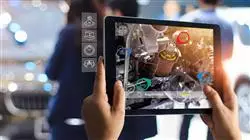University certificate
Scientific endorser

The world's largest faculty of engineering”
Introduction to the Program
Become an engineer specialized in digital transformation and apply your new knowledge in Blockchain, big data and artificial intelligence to your work"

For years now, the digital sphere has begun to occupy all kinds of spaces that were previously reserved for analog activities. Digitalization has radically transformed many tasks. Engineering and industry have not been exempt from this revolution, and digitalization has also made a strong entry into these disciplines.
Thus, concepts have become popular that will gradually gain more and more strength in today's society. Expressions such as blockchain, big data, artificial intelligence, augmented reality or the internet of things (IoT) are no longer as strange as they were a decade ago. These elements are here to stay and have already completely changed numerous professional fields. In the industrial field, these elements have brought about such a revolution that this area has already begun to be referred to as Industry 4.0.
Industry 4.0 integrates traditional engineering knowledge with these new concepts. Thus, industrial management has had to adapt to the new reality, incorporating more current notions to an area of study that until now had been very solid.
However, in order to become a true specialist in the field, an adequate learning process must be carried out to introduce these changes in the traditional industrial environment. For that reason, this Advanced Master’s Degree in Industrial Management and Digital Transformation is the degree that any engineer looking to boost his or her career should take. Its contents are focused on professional practice and have been drawn from the experience of great specialists who have been innovating in these areas for years, making this program the best educational degree that an ambitious engineer eager for new knowledge could achieve.
Digital transformation is influencing all industrial processes today: specialize and become the most in-demand engineer in the profession"
This Advanced master’s degree in Industrial Management and Digital Transformation contains the most complete and up-to-date scientific program on the market. The most important features include:
- Practical cases presented by experts in industrial Engineering and Digital Transformation
- The graphic, schematic, and eminently practical contents with which they are created, provide scientific and practical information on the disciplines that are essential for professional practice
- Practical exercises where the self-assessment process can be carried out to improve learning
- Its special focus on innovative methodologies in digital transformation applied to industrial management
- Theoretical lessons, questions to the expert, debate forums on controversial topics, and individual reflection work
- Content that is accessible from any fixed or portable device with an Internet connection
Digital transformation is the present and the future: specialize and start applying this knowledge to your work"
Its teaching staff includes professionals belonging to the field of industrial engineering and digital transformation, who bring their work experience to this program, as well as renowned specialists from leading companies and prestigious universities.
The multimedia content, developed with the latest educational technology, will provide the professional with situated and contextual learning, i.e., a simulated environment that will provide an immersive training experience designed to train for real-life situations.
This program is designed around Problem-Based Learning, whereby the student must try to solve the different professional practice situations that arise during the course. For this purpose, the professional will be assisted by an innovative interactive video system created by renowned and experienced experts.
Industrial management has undergone a revolution. If you want to learn how to adapt to this change, enroll in this Advanced master’s degree"

Become an expert in Industrial Management and Digital Transformation and watch how quickly you achieve all your professional goals"
Why study at TECH?
TECH is the world’s largest online university. With an impressive catalog of more than 14,000 university programs available in 11 languages, it is positioned as a leader in employability, with a 99% job placement rate. In addition, it relies on an enormous faculty of more than 6,000 professors of the highest international renown.

Study at the world's largest online university and guarantee your professional success. The future starts at TECH”
The world’s best online university according to FORBES
The prestigious Forbes magazine, specialized in business and finance, has highlighted TECH as “the world's best online university” This is what they have recently stated in an article in their digital edition in which they echo the success story of this institution, “thanks to the academic offer it provides, the selection of its teaching staff, and an innovative learning method aimed at educating the professionals of the future”
A revolutionary study method, a cutting-edge faculty and a practical focus: the key to TECH's success.
The most complete study plans on the university scene
TECH offers the most complete study plans on the university scene, with syllabuses that cover fundamental concepts and, at the same time, the main scientific advances in their specific scientific areas. In addition, these programs are continuously being updated to guarantee students the academic vanguard and the most in-demand professional skills. In this way, the university's qualifications provide its graduates with a significant advantage to propel their careers to success.
TECH offers the most comprehensive and intensive study plans on the current university scene.
A world-class teaching staff
TECH's teaching staff is made up of more than 6,000 professors with the highest international recognition. Professors, researchers and top executives of multinational companies, including Isaiah Covington, performance coach of the Boston Celtics; Magda Romanska, principal investigator at Harvard MetaLAB; Ignacio Wistumba, chairman of the department of translational molecular pathology at MD Anderson Cancer Center; and D.W. Pine, creative director of TIME magazine, among others.
Internationally renowned experts, specialized in different branches of Health, Technology, Communication and Business, form part of the TECH faculty.
A unique learning method
TECH is the first university to use Relearning in all its programs. It is the best online learning methodology, accredited with international teaching quality certifications, provided by prestigious educational agencies. In addition, this disruptive educational model is complemented with the “Case Method”, thereby setting up a unique online teaching strategy. Innovative teaching resources are also implemented, including detailed videos, infographics and interactive summaries.
TECH combines Relearning and the Case Method in all its university programs to guarantee excellent theoretical and practical learning, studying whenever and wherever you want.
The world's largest online university
TECH is the world’s largest online university. We are the largest educational institution, with the best and widest online educational catalog, one hundred percent online and covering the vast majority of areas of knowledge. We offer a large selection of our own degrees and accredited online undergraduate and postgraduate degrees. In total, more than 14,000 university degrees, in eleven different languages, make us the largest educational largest in the world.
TECH has the world's most extensive catalog of academic and official programs, available in more than 11 languages.
Google Premier Partner
The American technology giant has awarded TECH the Google Google Premier Partner badge. This award, which is only available to 3% of the world's companies, highlights the efficient, flexible and tailored experience that this university provides to students. The recognition as a Google Premier Partner not only accredits the maximum rigor, performance and investment in TECH's digital infrastructures, but also places this university as one of the world's leading technology companies.
Google has positioned TECH in the top 3% of the world's most important technology companies by awarding it its Google Premier Partner badge.
The official online university of the NBA
TECH is the official online university of the NBA. Thanks to our agreement with the biggest league in basketball, we offer our students exclusive university programs, as well as a wide variety of educational resources focused on the business of the league and other areas of the sports industry. Each program is made up of a uniquely designed syllabus and features exceptional guest hosts: professionals with a distinguished sports background who will offer their expertise on the most relevant topics.
TECH has been selected by the NBA, the world's top basketball league, as its official online university.
The top-rated university by its students
Students have positioned TECH as the world's top-rated university on the main review websites, with a highest rating of 4.9 out of 5, obtained from more than 1,000 reviews. These results consolidate TECH as the benchmark university institution at an international level, reflecting the excellence and positive impact of its educational model.” reflecting the excellence and positive impact of its educational model.”
TECH is the world’s top-rated university by its students.
Leaders in employability
TECH has managed to become the leading university in employability. 99% of its students obtain jobs in the academic field they have studied, within one year of completing any of the university's programs. A similar number achieve immediate career enhancement. All this thanks to a study methodology that bases its effectiveness on the acquisition of practical skills, which are absolutely necessary for professional development.
99% of TECH graduates find a job within a year of completing their studies.
Advanced Master's Degree in Industrial Management and Digital Transformation
The integration of elements such as the internet of things (IoT), blockchain, big data and artificial intelligence to business environments has meant a change in the way in which various tasks were carried out. Although the emergence of technologies, programs and digital concepts has favored the management of procedures and information, optimizing time and providing greater assurance and security, it has also represented a challenge for the sector, especially when it comes to finding highly trained personnel to successfully develop in the functions that the role as industrial and digital transformation manager implies. At TECH Global University we have developed the Advanced Master's Degree in Industrial Management and Digital Transformation, a program designed with the purpose of you acquiring new knowledge and tools so that you can apply them to your work environment, outline your skills and succeed in this discipline.
Specialize in geotechnical engineering and foundations
If one of your goals as an engineering professional is to visualize, innovate and be part of the future of new technologies and methodologies applied to industry 4.0 in the digitalization market, this program is for you. Become a specialist in digital transformation and stand out with your new knowledge in Blockchain, Big Data and Artificial Intelligence (AI). In this program, presented in a 100% online format, you will conduct a comprehensive analysis on the paradigm shift in the sector due to technology; you will bring your skills to face and lead the technological leap in companies and participate in the automation of their processes to create new fields of wealth in areas such as creativity, innovation and technological efficiency. Advance your professional goals and become an expert in the largest School of Engineering in the world.







